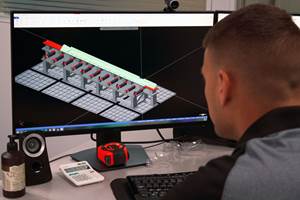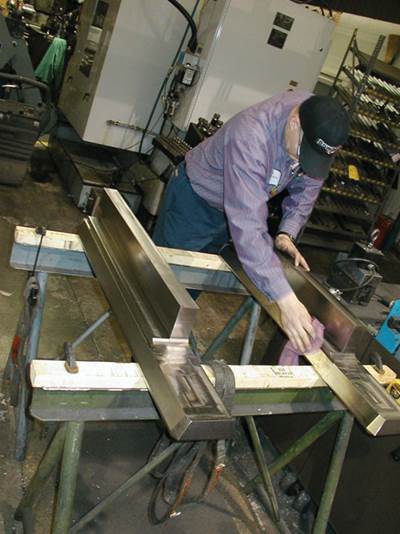To the uninitiated, plunge roughing might not appear much different than drilling cycles. Essentially, the technique involves taking a series of overlapping passes that cut into the workpiece along the Z-axis, eliminating side pressure and directing cutting forces into the spindle.
However, belying the technique’s simplistic outward appearance is the fact that it involves considerations far beyond drilling. According to software developer Gibbs and Associates, that’s reason enough to carefully scrutinize any CAM software that purports to perform this technique. Outlined below are a number of factors that, according to the company, are essential for any CAM system’s capacity for programming effective plunge roughing routines.
Beyond Drilling
Unlike relatively simple hole-drilling operations, plunge roughing might involve surfaces that are angular, irregular or freeform, or that include a perimeter contour. These are all conditions that require special offsets for changing depth and direction. Not to mention that unlike a drill, the cutting tool cannot retract along the same path used to cut into the work. Rather, the tool must pull away from the cut first to avoid hitting the stock and chipping the inserts.
Of course, it might be worthwhile to attempt plunge roughing via a drill cycle without CAM software if certain conditions are met: if programmers have the time and patience to calculate locations and program pull-off motion before every retraction, if the volume to be cleared is large, and if the surface is flat and parallel to the X-Y axis. Another factor to consider is whether such a programming effort can be amortized over a large number of parts. Otherwise, however, shops would be better served by CAM software that can handle all the roughing situations they are likely to encounter while minimizing programmer effort, the company says.
The Minimal Requirement
According to Gibbs, the lowest common denominator for any plunge-roughing CAM software is the ability to automatically generate pull-off motion before retraction, as mentioned above. This will protect the cutting tool and enable rapid motion between plunges. It will also protect the workpiece if plunge roughing is used to get very close to final finish. Allowing the user to specify pull-off distance (angle and length) provides allowance for center-cutting tools, straight inserts and angled inserts so that pull-off is as fast as material and tool conditions permit without inserts rubbing and chipping at the bottom of the cut.
Containment and Boundaries
Even with workpieces that are completely flat, CAM software must permit users to identify stock and containment regions or boundaries to restrict the plunge tool in depth and lateral motion. The software should specify cutting regions similarly to the way it handles surfaces, the company says. While this is relatively simple for 2.5-axis machining, 3-axis work is more of a challenge. Ideally, the software would provide easily selectable methods to define the extent of the volume to be roughed. This includes surfaces to define the bottoms of cuts, geometry to define surfaces above which roughing should be excluded, and stock or other already available geometry to define where rapid moves need to shift to the programmed feed rate.
Cutting Direction and Patterns
Another consideration is that CAM software should have the flexibility to allow various cutting directions, the company says. At minimum, it should enable straight-line nibbling along a user-specified angle. A drill pattern, for example, would provide a grid of points within a containment area.
Circular motion is desirable when plunge roughing is performed as a face operation on any type of turning machine, and, for efficiency, when a shape requiring roughing on a mill or machining center is closer to a circle than a rectangle. This requires the ability to specify beginning and ending radii, to prevent time wasted programming plunges along individual radial lines from center to edge and back. A contour pattern provides plunging along a curve or section of geometry with a given offset. Perhaps the most valuable capability is the capacity to define a pattern by selecting an area between two curves. This permits roughing without specifying an entire closed area.
Alternating Direction
Software that enables alternating directions between plunge passes to minimize travel can provide additional efficiency, the company says. That way, when plunging is complete along a line or circular motion, the tool moves into the closest, un-roughed area and begins moving in the opposite direction. This would consist of alternating, zigzag passes for a linear pattern and alternating clockwise and counter-clockwise for a circular pattern.
Cavities and Cores
CNC programmers can save a lot of time if the CAM system allows for both cavities and cores, and if it can easily move from the inside out or outside in to accommodate standing and sunken features equally. According to Gibbs, these capabilities eliminate the need to waste time creating additional containment geometry to “fool” the software.
Offsets and Pull-Off Direction
For freeform or complex geometry, the software should be able to compensate for changes in direction when determining offsets and pull-off direction. Otherwise, the programmer will be severely restricted, the company says. As a simple example, it cites a domed surface where plunging begins going uphill. Upon reaching the top, the tool should not proceed. That’s because pulling off from any plunge beyond the top of the dome would push the tool into the workpiece, while pulling off in the other direction would drive the tool into deeper uncut material and possibly damage it.
The situation is similar with the mirror or mold image of this geometry. In that case, plunging must begin at the bottom, either with preliminary drilling to open the space for a plunge mill or beginning at the lower point with a center-cutting plunge mill, which then moves up toward the top of the dome so that it can pull off into cleared space. For this type of scenario, the software should also provide the option to begin clearing an area that will be concave with a drilled hole—as long as plunging is not done with a center-cutting tool.
Channels and Islands
Tight areas can cause problems for inadequate software, the company says. For example, when plunging between islands or to create a channel, the pull-off before the stepover should not gouge an adjacent island or opposite wall.
The Overriding Factors
All of these challenges should be considered by shops that are considering plunge roughing but don’t have CAM software with special motion and flexibility required to use the process efficiently. The company says the latest version of its GibbsCAM software incorporates new plunge roughing routines that take all these issues into account, as evidenced by the experience of two shops that recently implemented the technique. (To read about how these companies, Norfolk Specialties and Ouverson Engineering and Machine, adopted plunge roughing, click the article under “editor’s picks” at the top right corner of this page.)
Of course, various software packages address these challenges in different ways. According to Gibbs, the most important considerations are ease of use and flexibility for the user. After all, the whole purpose of plunge roughing is to save time.

















.png;maxWidth=300;quality=90)








